Meta-Analysis: Exploring Job Crafting and Job Satisfaction Dynamics
VerifiedAdded on 2023/06/11
|11
|2581
|188
Report
AI Summary
This report presents a meta-analysis investigating the relationship between job crafting and job satisfaction. It outlines the research questions, inclusion/exclusion criteria for studies, and the search strategies employed. The meta-analysis synthesizes findings from multiple studies, examining the impact of job crafting on job satisfaction across different contexts and time periods. The study also considers variables such as gender, age, and managerial levels. The findings highlight the importance of resourcefulness and job restructuring in achieving job satisfaction, emphasizing the role of proactive work behavior in modifying job characteristics. The research uses meta-analytic measures to compare and interpret the relevance of job crafting, concluding that employees should reorganize their jobs with necessary resources to increase job satisfaction. Desklib provides access to similar research papers and solved assignments for students.
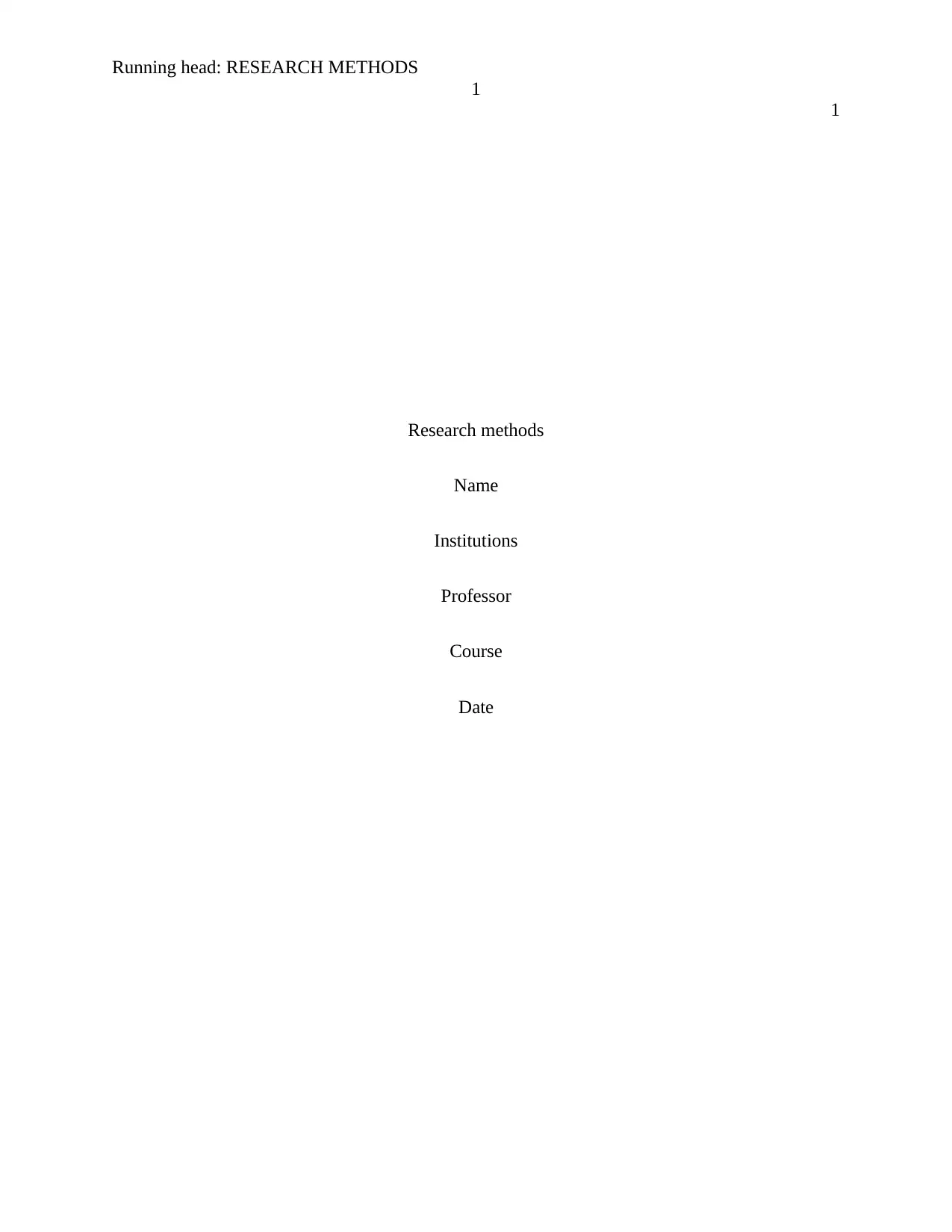
Running head: RESEARCH METHODS
1
1
Research methods
Name
Institutions
Professor
Course
Date
1
1
Research methods
Name
Institutions
Professor
Course
Date
Paraphrase This Document
Need a fresh take? Get an instant paraphrase of this document with our AI Paraphraser
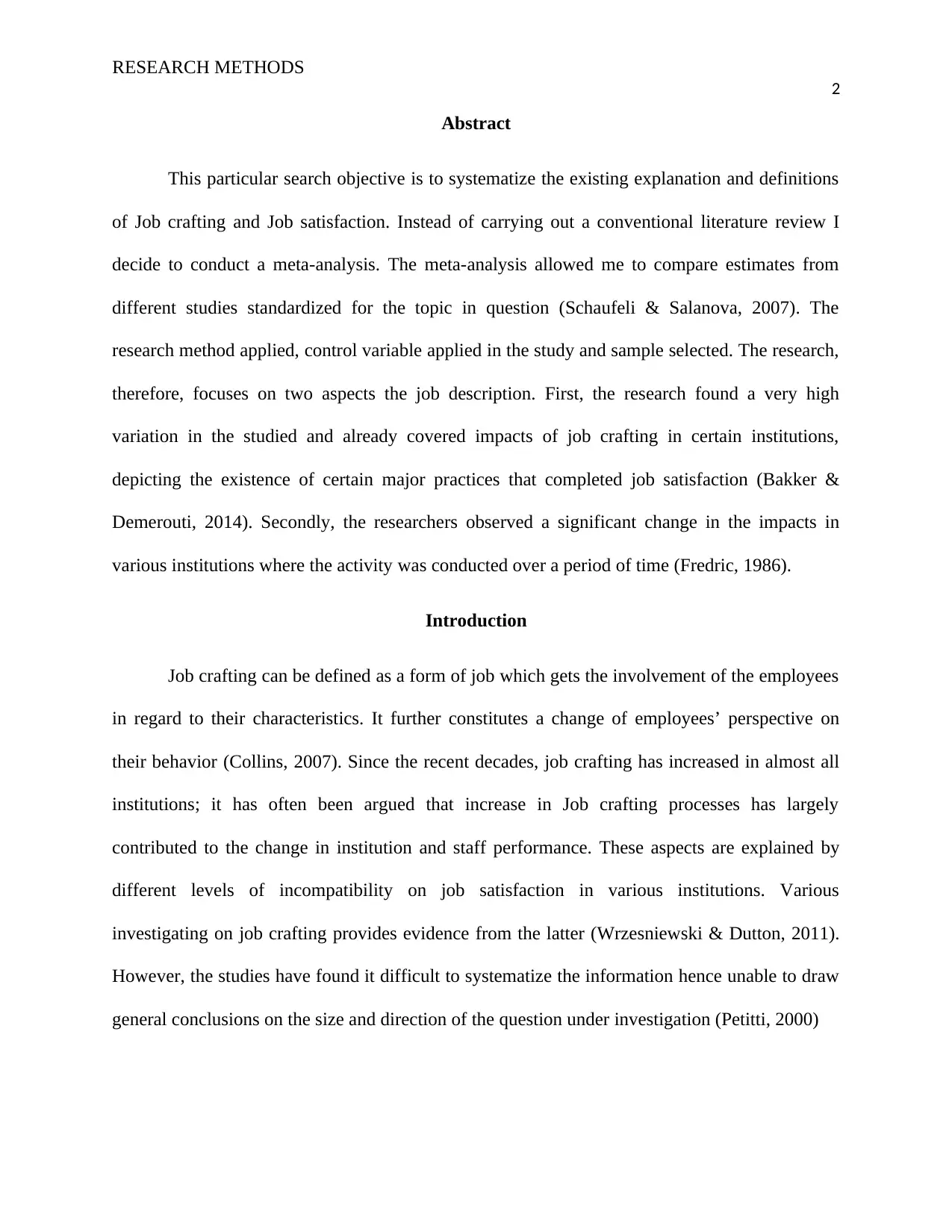
RESEARCH METHODS
2
Abstract
This particular search objective is to systematize the existing explanation and definitions
of Job crafting and Job satisfaction. Instead of carrying out a conventional literature review I
decide to conduct a meta-analysis. The meta-analysis allowed me to compare estimates from
different studies standardized for the topic in question (Schaufeli & Salanova, 2007). The
research method applied, control variable applied in the study and sample selected. The research,
therefore, focuses on two aspects the job description. First, the research found a very high
variation in the studied and already covered impacts of job crafting in certain institutions,
depicting the existence of certain major practices that completed job satisfaction (Bakker &
Demerouti, 2014). Secondly, the researchers observed a significant change in the impacts in
various institutions where the activity was conducted over a period of time (Fredric, 1986).
Introduction
Job crafting can be defined as a form of job which gets the involvement of the employees
in regard to their characteristics. It further constitutes a change of employees’ perspective on
their behavior (Collins, 2007). Since the recent decades, job crafting has increased in almost all
institutions; it has often been argued that increase in Job crafting processes has largely
contributed to the change in institution and staff performance. These aspects are explained by
different levels of incompatibility on job satisfaction in various institutions. Various
investigating on job crafting provides evidence from the latter (Wrzesniewski & Dutton, 2011).
However, the studies have found it difficult to systematize the information hence unable to draw
general conclusions on the size and direction of the question under investigation (Petitti, 2000)
2
Abstract
This particular search objective is to systematize the existing explanation and definitions
of Job crafting and Job satisfaction. Instead of carrying out a conventional literature review I
decide to conduct a meta-analysis. The meta-analysis allowed me to compare estimates from
different studies standardized for the topic in question (Schaufeli & Salanova, 2007). The
research method applied, control variable applied in the study and sample selected. The research,
therefore, focuses on two aspects the job description. First, the research found a very high
variation in the studied and already covered impacts of job crafting in certain institutions,
depicting the existence of certain major practices that completed job satisfaction (Bakker &
Demerouti, 2014). Secondly, the researchers observed a significant change in the impacts in
various institutions where the activity was conducted over a period of time (Fredric, 1986).
Introduction
Job crafting can be defined as a form of job which gets the involvement of the employees
in regard to their characteristics. It further constitutes a change of employees’ perspective on
their behavior (Collins, 2007). Since the recent decades, job crafting has increased in almost all
institutions; it has often been argued that increase in Job crafting processes has largely
contributed to the change in institution and staff performance. These aspects are explained by
different levels of incompatibility on job satisfaction in various institutions. Various
investigating on job crafting provides evidence from the latter (Wrzesniewski & Dutton, 2011).
However, the studies have found it difficult to systematize the information hence unable to draw
general conclusions on the size and direction of the question under investigation (Petitti, 2000)

RESEARCH METHODS
3
The paper systematizes the existing literature relation of job crafting as well as job
satisfaction. Meta-analytical techniques were used in place of a literature review in order to have
a qualitative approach (Petrou et al, 2012). The reason for application of a meta-analysis in the
research is to evade substantial biases that can be as a result of a literature review that allows
quantitative assessment. Therefore this analysis will provide a systematic and vivid method of
comparing the results of different studies on the comparison (Kim & Lee, 2016).
Research Questions
a. what are the effects of the job crafting in regard to the job satisfaction?
b. what is the impacts of the job crafting to the job satisfaction?
The Inclusion form of the procedure and the Exclusion
The search form of the procedure for the existing articles and Google content
It is all about key words in the Google engine
1. It focuses on Google browser
2. Search engines
3. Browsing history
4. Social search
Inclusion process
1. This process should have the concept of the job crafting
2. It should involve the analysis of the statistics
3. It must have the publication in as the international journal article
3
The paper systematizes the existing literature relation of job crafting as well as job
satisfaction. Meta-analytical techniques were used in place of a literature review in order to have
a qualitative approach (Petrou et al, 2012). The reason for application of a meta-analysis in the
research is to evade substantial biases that can be as a result of a literature review that allows
quantitative assessment. Therefore this analysis will provide a systematic and vivid method of
comparing the results of different studies on the comparison (Kim & Lee, 2016).
Research Questions
a. what are the effects of the job crafting in regard to the job satisfaction?
b. what is the impacts of the job crafting to the job satisfaction?
The Inclusion form of the procedure and the Exclusion
The search form of the procedure for the existing articles and Google content
It is all about key words in the Google engine
1. It focuses on Google browser
2. Search engines
3. Browsing history
4. Social search
Inclusion process
1. This process should have the concept of the job crafting
2. It should involve the analysis of the statistics
3. It must have the publication in as the international journal article
⊘ This is a preview!⊘
Do you want full access?
Subscribe today to unlock all pages.

Trusted by 1+ million students worldwide
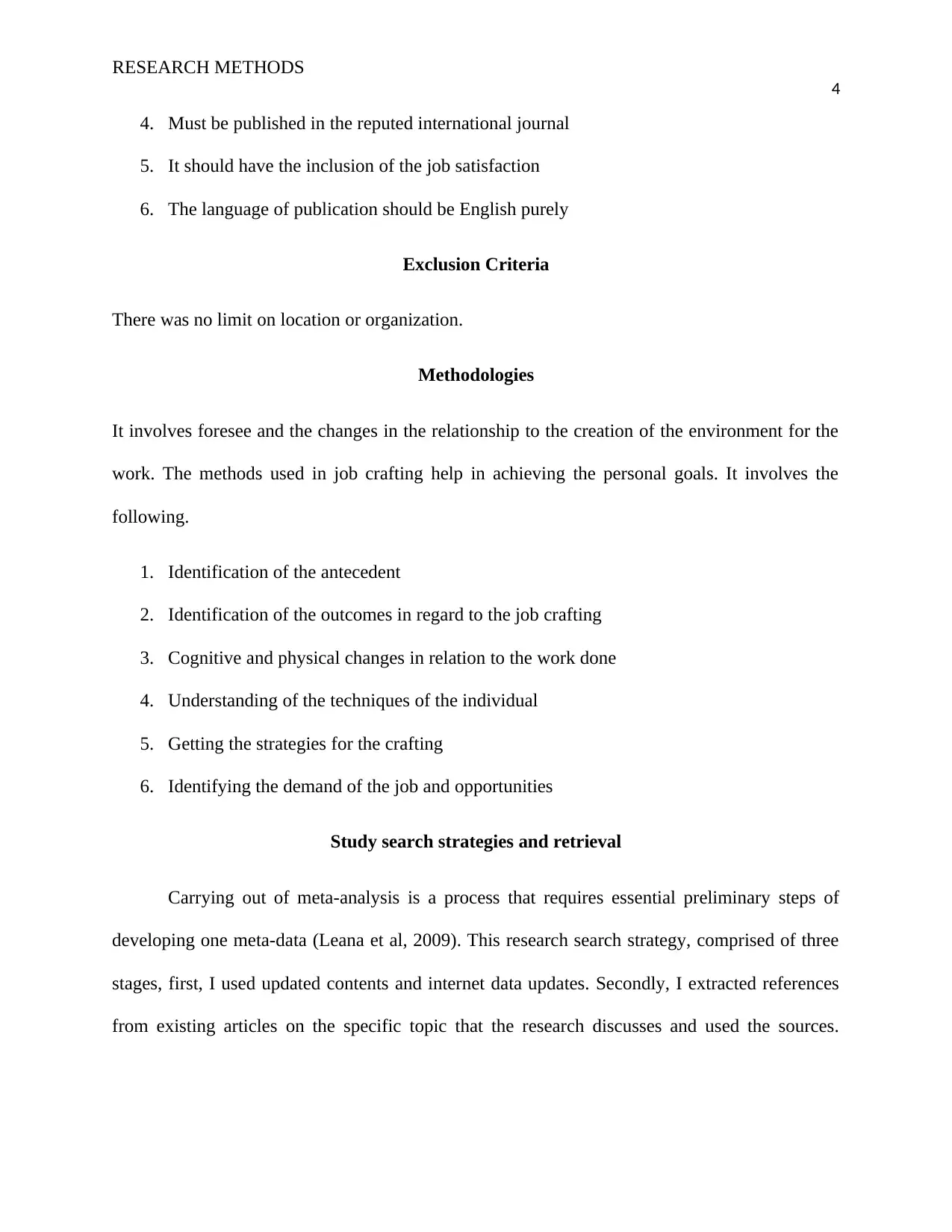
RESEARCH METHODS
4
4. Must be published in the reputed international journal
5. It should have the inclusion of the job satisfaction
6. The language of publication should be English purely
Exclusion Criteria
There was no limit on location or organization.
Methodologies
It involves foresee and the changes in the relationship to the creation of the environment for the
work. The methods used in job crafting help in achieving the personal goals. It involves the
following.
1. Identification of the antecedent
2. Identification of the outcomes in regard to the job crafting
3. Cognitive and physical changes in relation to the work done
4. Understanding of the techniques of the individual
5. Getting the strategies for the crafting
6. Identifying the demand of the job and opportunities
Study search strategies and retrieval
Carrying out of meta-analysis is a process that requires essential preliminary steps of
developing one meta-data (Leana et al, 2009). This research search strategy, comprised of three
stages, first, I used updated contents and internet data updates. Secondly, I extracted references
from existing articles on the specific topic that the research discusses and used the sources.
4
4. Must be published in the reputed international journal
5. It should have the inclusion of the job satisfaction
6. The language of publication should be English purely
Exclusion Criteria
There was no limit on location or organization.
Methodologies
It involves foresee and the changes in the relationship to the creation of the environment for the
work. The methods used in job crafting help in achieving the personal goals. It involves the
following.
1. Identification of the antecedent
2. Identification of the outcomes in regard to the job crafting
3. Cognitive and physical changes in relation to the work done
4. Understanding of the techniques of the individual
5. Getting the strategies for the crafting
6. Identifying the demand of the job and opportunities
Study search strategies and retrieval
Carrying out of meta-analysis is a process that requires essential preliminary steps of
developing one meta-data (Leana et al, 2009). This research search strategy, comprised of three
stages, first, I used updated contents and internet data updates. Secondly, I extracted references
from existing articles on the specific topic that the research discusses and used the sources.
Paraphrase This Document
Need a fresh take? Get an instant paraphrase of this document with our AI Paraphraser
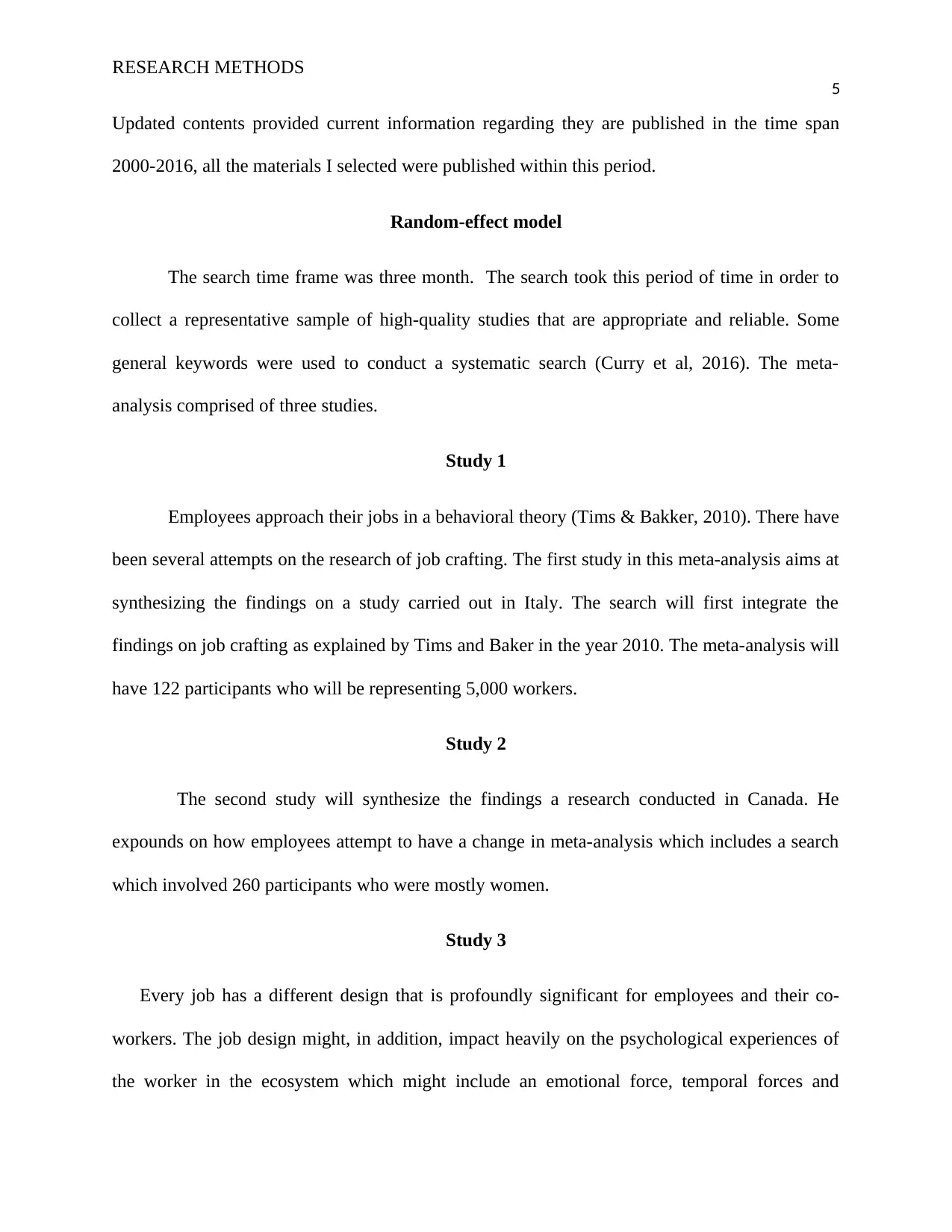
RESEARCH METHODS
5
Updated contents provided current information regarding they are published in the time span
2000-2016, all the materials I selected were published within this period.
Random-effect model
The search time frame was three month. The search took this period of time in order to
collect a representative sample of high-quality studies that are appropriate and reliable. Some
general keywords were used to conduct a systematic search (Curry et al, 2016). The meta-
analysis comprised of three studies.
Study 1
Employees approach their jobs in a behavioral theory (Tims & Bakker, 2010). There have
been several attempts on the research of job crafting. The first study in this meta-analysis aims at
synthesizing the findings on a study carried out in Italy. The search will first integrate the
findings on job crafting as explained by Tims and Baker in the year 2010. The meta-analysis will
have 122 participants who will be representing 5,000 workers.
Study 2
The second study will synthesize the findings a research conducted in Canada. He
expounds on how employees attempt to have a change in meta-analysis which includes a search
which involved 260 participants who were mostly women.
Study 3
Every job has a different design that is profoundly significant for employees and their co-
workers. The job design might, in addition, impact heavily on the psychological experiences of
the worker in the ecosystem which might include an emotional force, temporal forces and
5
Updated contents provided current information regarding they are published in the time span
2000-2016, all the materials I selected were published within this period.
Random-effect model
The search time frame was three month. The search took this period of time in order to
collect a representative sample of high-quality studies that are appropriate and reliable. Some
general keywords were used to conduct a systematic search (Curry et al, 2016). The meta-
analysis comprised of three studies.
Study 1
Employees approach their jobs in a behavioral theory (Tims & Bakker, 2010). There have
been several attempts on the research of job crafting. The first study in this meta-analysis aims at
synthesizing the findings on a study carried out in Italy. The search will first integrate the
findings on job crafting as explained by Tims and Baker in the year 2010. The meta-analysis will
have 122 participants who will be representing 5,000 workers.
Study 2
The second study will synthesize the findings a research conducted in Canada. He
expounds on how employees attempt to have a change in meta-analysis which includes a search
which involved 260 participants who were mostly women.
Study 3
Every job has a different design that is profoundly significant for employees and their co-
workers. The job design might, in addition, impact heavily on the psychological experiences of
the worker in the ecosystem which might include an emotional force, temporal forces and
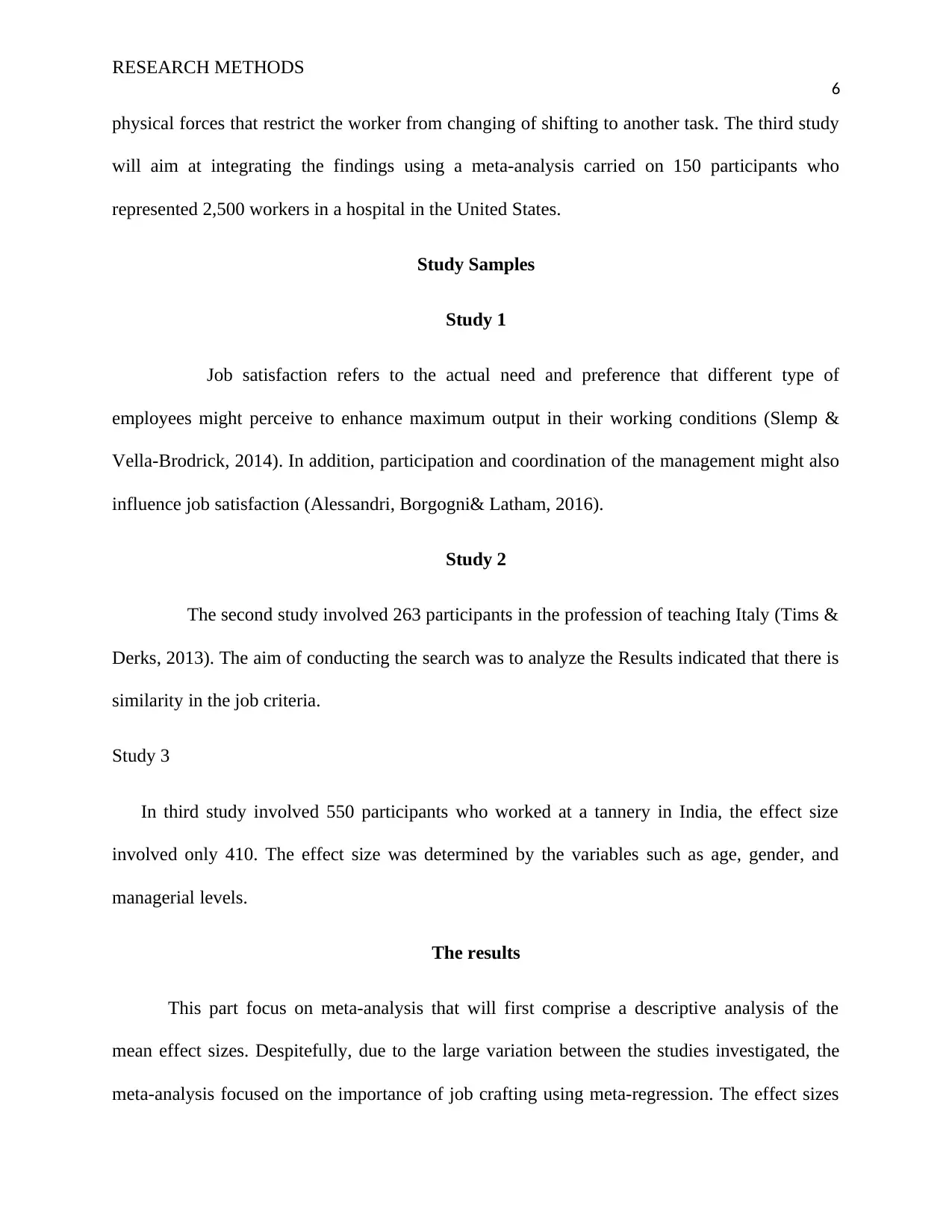
RESEARCH METHODS
6
physical forces that restrict the worker from changing of shifting to another task. The third study
will aim at integrating the findings using a meta-analysis carried on 150 participants who
represented 2,500 workers in a hospital in the United States.
Study Samples
Study 1
Job satisfaction refers to the actual need and preference that different type of
employees might perceive to enhance maximum output in their working conditions (Slemp &
Vella-Brodrick, 2014). In addition, participation and coordination of the management might also
influence job satisfaction (Alessandri, Borgogni& Latham, 2016).
Study 2
The second study involved 263 participants in the profession of teaching Italy (Tims &
Derks, 2013). The aim of conducting the search was to analyze the Results indicated that there is
similarity in the job criteria.
Study 3
In third study involved 550 participants who worked at a tannery in India, the effect size
involved only 410. The effect size was determined by the variables such as age, gender, and
managerial levels.
The results
This part focus on meta-analysis that will first comprise a descriptive analysis of the
mean effect sizes. Despitefully, due to the large variation between the studies investigated, the
meta-analysis focused on the importance of job crafting using meta-regression. The effect sizes
6
physical forces that restrict the worker from changing of shifting to another task. The third study
will aim at integrating the findings using a meta-analysis carried on 150 participants who
represented 2,500 workers in a hospital in the United States.
Study Samples
Study 1
Job satisfaction refers to the actual need and preference that different type of
employees might perceive to enhance maximum output in their working conditions (Slemp &
Vella-Brodrick, 2014). In addition, participation and coordination of the management might also
influence job satisfaction (Alessandri, Borgogni& Latham, 2016).
Study 2
The second study involved 263 participants in the profession of teaching Italy (Tims &
Derks, 2013). The aim of conducting the search was to analyze the Results indicated that there is
similarity in the job criteria.
Study 3
In third study involved 550 participants who worked at a tannery in India, the effect size
involved only 410. The effect size was determined by the variables such as age, gender, and
managerial levels.
The results
This part focus on meta-analysis that will first comprise a descriptive analysis of the
mean effect sizes. Despitefully, due to the large variation between the studies investigated, the
meta-analysis focused on the importance of job crafting using meta-regression. The effect sizes
⊘ This is a preview!⊘
Do you want full access?
Subscribe today to unlock all pages.

Trusted by 1+ million students worldwide
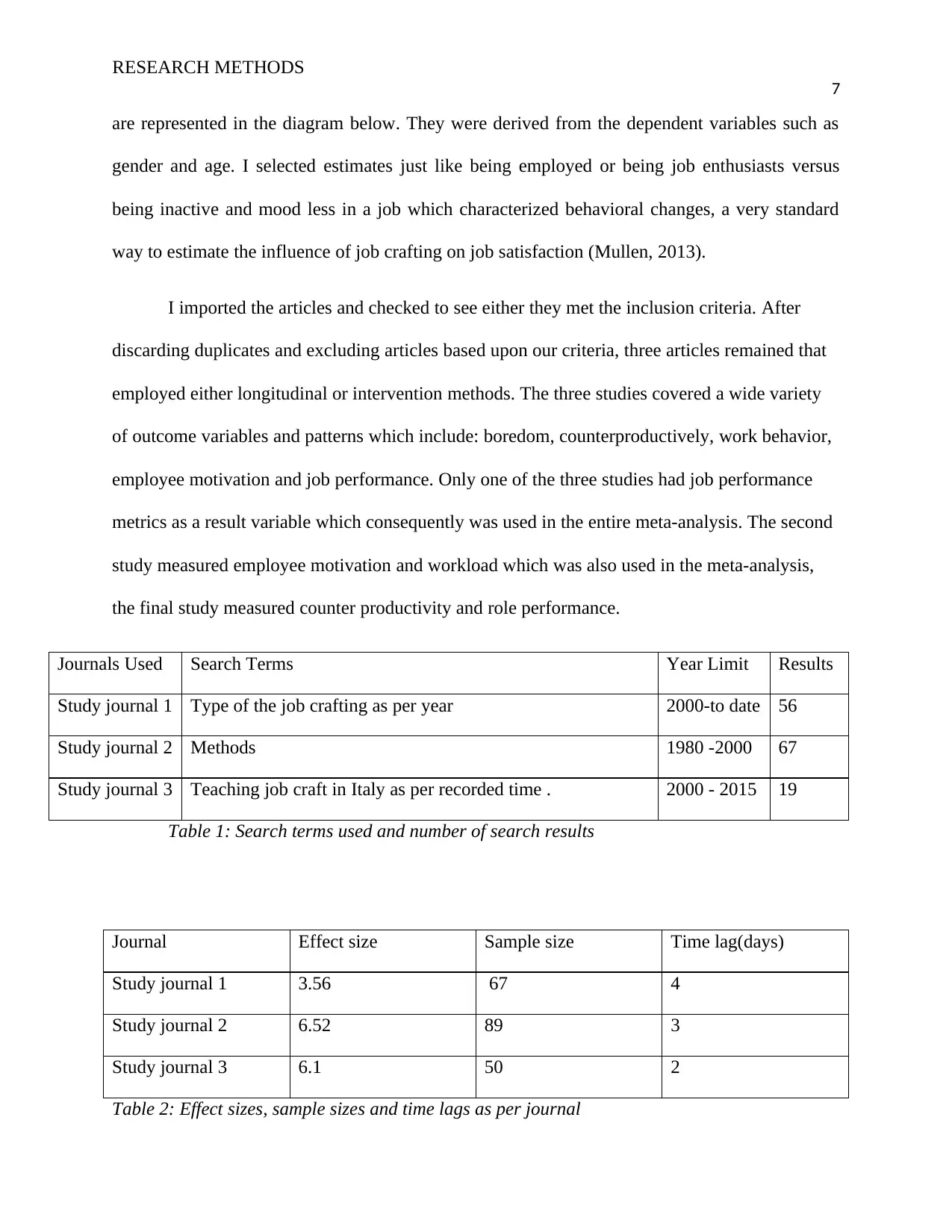
RESEARCH METHODS
7
are represented in the diagram below. They were derived from the dependent variables such as
gender and age. I selected estimates just like being employed or being job enthusiasts versus
being inactive and mood less in a job which characterized behavioral changes, a very standard
way to estimate the influence of job crafting on job satisfaction (Mullen, 2013).
I imported the articles and checked to see either they met the inclusion criteria. After
discarding duplicates and excluding articles based upon our criteria, three articles remained that
employed either longitudinal or intervention methods. The three studies covered a wide variety
of outcome variables and patterns which include: boredom, counterproductively, work behavior,
employee motivation and job performance. Only one of the three studies had job performance
metrics as a result variable which consequently was used in the entire meta-analysis. The second
study measured employee motivation and workload which was also used in the meta-analysis,
the final study measured counter productivity and role performance.
Journals Used Search Terms Year Limit Results
Study journal 1 Type of the job crafting as per year 2000-to date 56
Study journal 2 Methods 1980 -2000 67
Study journal 3 Teaching job craft in Italy as per recorded time . 2000 - 2015 19
Table 1: Search terms used and number of search results
Journal Effect size Sample size Time lag(days)
Study journal 1 3.56 67 4
Study journal 2 6.52 89 3
Study journal 3 6.1 50 2
Table 2: Effect sizes, sample sizes and time lags as per journal
7
are represented in the diagram below. They were derived from the dependent variables such as
gender and age. I selected estimates just like being employed or being job enthusiasts versus
being inactive and mood less in a job which characterized behavioral changes, a very standard
way to estimate the influence of job crafting on job satisfaction (Mullen, 2013).
I imported the articles and checked to see either they met the inclusion criteria. After
discarding duplicates and excluding articles based upon our criteria, three articles remained that
employed either longitudinal or intervention methods. The three studies covered a wide variety
of outcome variables and patterns which include: boredom, counterproductively, work behavior,
employee motivation and job performance. Only one of the three studies had job performance
metrics as a result variable which consequently was used in the entire meta-analysis. The second
study measured employee motivation and workload which was also used in the meta-analysis,
the final study measured counter productivity and role performance.
Journals Used Search Terms Year Limit Results
Study journal 1 Type of the job crafting as per year 2000-to date 56
Study journal 2 Methods 1980 -2000 67
Study journal 3 Teaching job craft in Italy as per recorded time . 2000 - 2015 19
Table 1: Search terms used and number of search results
Journal Effect size Sample size Time lag(days)
Study journal 1 3.56 67 4
Study journal 2 6.52 89 3
Study journal 3 6.1 50 2
Table 2: Effect sizes, sample sizes and time lags as per journal
Paraphrase This Document
Need a fresh take? Get an instant paraphrase of this document with our AI Paraphraser
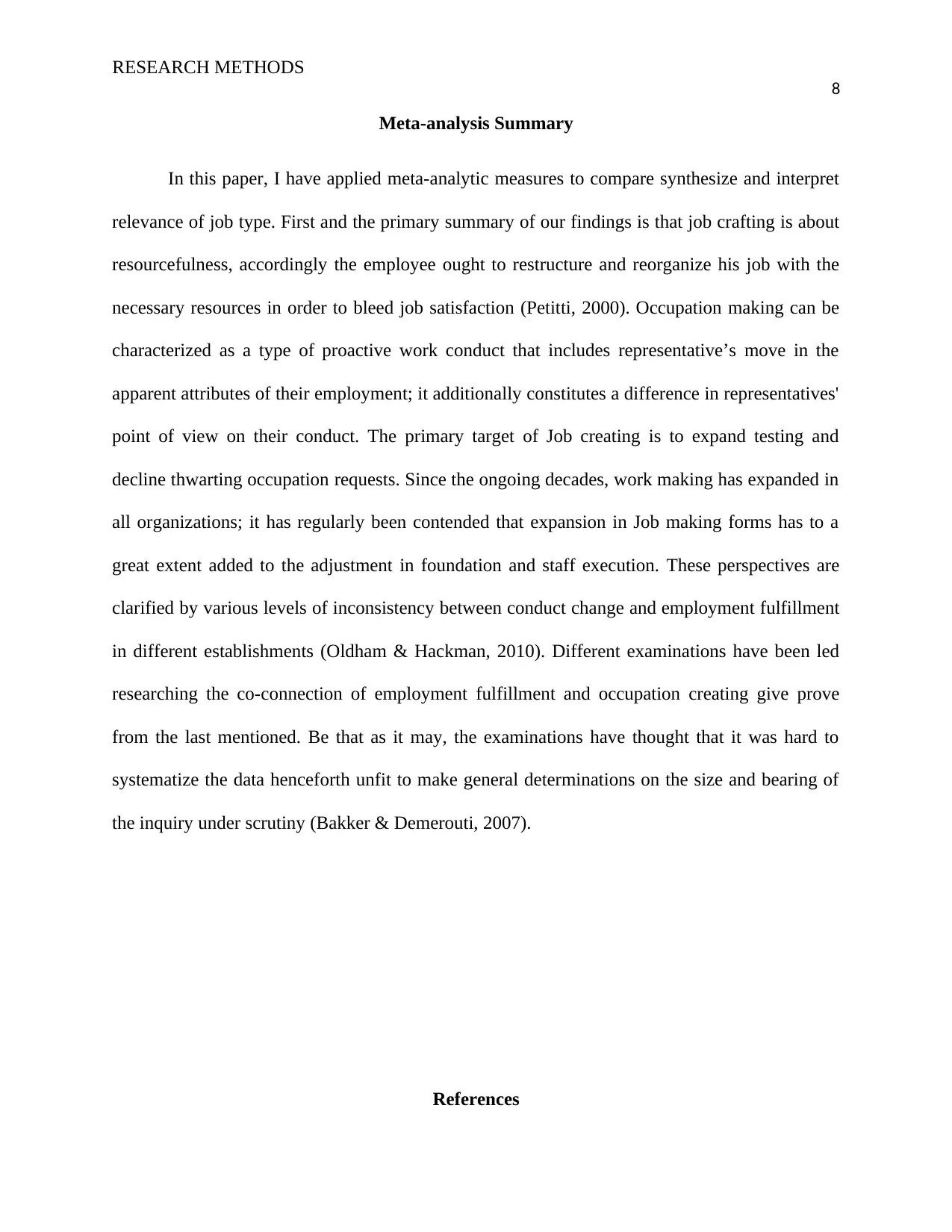
RESEARCH METHODS
8
Meta-analysis Summary
In this paper, I have applied meta-analytic measures to compare synthesize and interpret
relevance of job type. First and the primary summary of our findings is that job crafting is about
resourcefulness, accordingly the employee ought to restructure and reorganize his job with the
necessary resources in order to bleed job satisfaction (Petitti, 2000). Occupation making can be
characterized as a type of proactive work conduct that includes representative’s move in the
apparent attributes of their employment; it additionally constitutes a difference in representatives'
point of view on their conduct. The primary target of Job creating is to expand testing and
decline thwarting occupation requests. Since the ongoing decades, work making has expanded in
all organizations; it has regularly been contended that expansion in Job making forms has to a
great extent added to the adjustment in foundation and staff execution. These perspectives are
clarified by various levels of inconsistency between conduct change and employment fulfillment
in different establishments (Oldham & Hackman, 2010). Different examinations have been led
researching the co-connection of employment fulfillment and occupation creating give prove
from the last mentioned. Be that as it may, the examinations have thought that it was hard to
systematize the data henceforth unfit to make general determinations on the size and bearing of
the inquiry under scrutiny (Bakker & Demerouti, 2007).
References
8
Meta-analysis Summary
In this paper, I have applied meta-analytic measures to compare synthesize and interpret
relevance of job type. First and the primary summary of our findings is that job crafting is about
resourcefulness, accordingly the employee ought to restructure and reorganize his job with the
necessary resources in order to bleed job satisfaction (Petitti, 2000). Occupation making can be
characterized as a type of proactive work conduct that includes representative’s move in the
apparent attributes of their employment; it additionally constitutes a difference in representatives'
point of view on their conduct. The primary target of Job creating is to expand testing and
decline thwarting occupation requests. Since the ongoing decades, work making has expanded in
all organizations; it has regularly been contended that expansion in Job making forms has to a
great extent added to the adjustment in foundation and staff execution. These perspectives are
clarified by various levels of inconsistency between conduct change and employment fulfillment
in different establishments (Oldham & Hackman, 2010). Different examinations have been led
researching the co-connection of employment fulfillment and occupation creating give prove
from the last mentioned. Be that as it may, the examinations have thought that it was hard to
systematize the data henceforth unfit to make general determinations on the size and bearing of
the inquiry under scrutiny (Bakker & Demerouti, 2007).
References
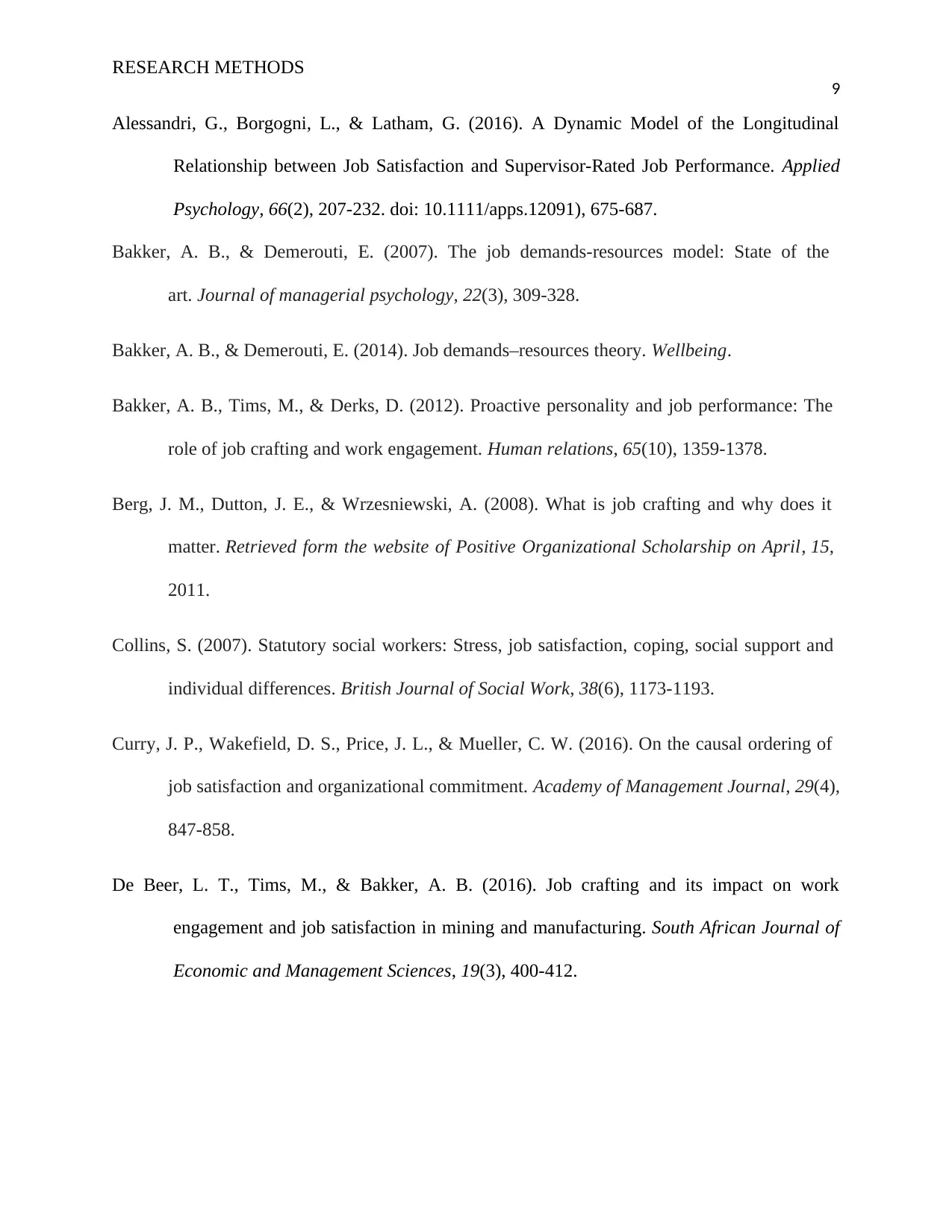
RESEARCH METHODS
9
Alessandri, G., Borgogni, L., & Latham, G. (2016). A Dynamic Model of the Longitudinal
Relationship between Job Satisfaction and Supervisor-Rated Job Performance. Applied
Psychology, 66(2), 207-232. doi: 10.1111/apps.12091), 675-687.
Bakker, A. B., & Demerouti, E. (2007). The job demands-resources model: State of the
art. Journal of managerial psychology, 22(3), 309-328.
Bakker, A. B., & Demerouti, E. (2014). Job demands–resources theory. Wellbeing.
Bakker, A. B., Tims, M., & Derks, D. (2012). Proactive personality and job performance: The
role of job crafting and work engagement. Human relations, 65(10), 1359-1378.
Berg, J. M., Dutton, J. E., & Wrzesniewski, A. (2008). What is job crafting and why does it
matter. Retrieved form the website of Positive Organizational Scholarship on April, 15,
2011.
Collins, S. (2007). Statutory social workers: Stress, job satisfaction, coping, social support and
individual differences. British Journal of Social Work, 38(6), 1173-1193.
Curry, J. P., Wakefield, D. S., Price, J. L., & Mueller, C. W. (2016). On the causal ordering of
job satisfaction and organizational commitment. Academy of Management Journal, 29(4),
847-858.
De Beer, L. T., Tims, M., & Bakker, A. B. (2016). Job crafting and its impact on work
engagement and job satisfaction in mining and manufacturing. South African Journal of
Economic and Management Sciences, 19(3), 400-412.
9
Alessandri, G., Borgogni, L., & Latham, G. (2016). A Dynamic Model of the Longitudinal
Relationship between Job Satisfaction and Supervisor-Rated Job Performance. Applied
Psychology, 66(2), 207-232. doi: 10.1111/apps.12091), 675-687.
Bakker, A. B., & Demerouti, E. (2007). The job demands-resources model: State of the
art. Journal of managerial psychology, 22(3), 309-328.
Bakker, A. B., & Demerouti, E. (2014). Job demands–resources theory. Wellbeing.
Bakker, A. B., Tims, M., & Derks, D. (2012). Proactive personality and job performance: The
role of job crafting and work engagement. Human relations, 65(10), 1359-1378.
Berg, J. M., Dutton, J. E., & Wrzesniewski, A. (2008). What is job crafting and why does it
matter. Retrieved form the website of Positive Organizational Scholarship on April, 15,
2011.
Collins, S. (2007). Statutory social workers: Stress, job satisfaction, coping, social support and
individual differences. British Journal of Social Work, 38(6), 1173-1193.
Curry, J. P., Wakefield, D. S., Price, J. L., & Mueller, C. W. (2016). On the causal ordering of
job satisfaction and organizational commitment. Academy of Management Journal, 29(4),
847-858.
De Beer, L. T., Tims, M., & Bakker, A. B. (2016). Job crafting and its impact on work
engagement and job satisfaction in mining and manufacturing. South African Journal of
Economic and Management Sciences, 19(3), 400-412.
⊘ This is a preview!⊘
Do you want full access?
Subscribe today to unlock all pages.

Trusted by 1+ million students worldwide
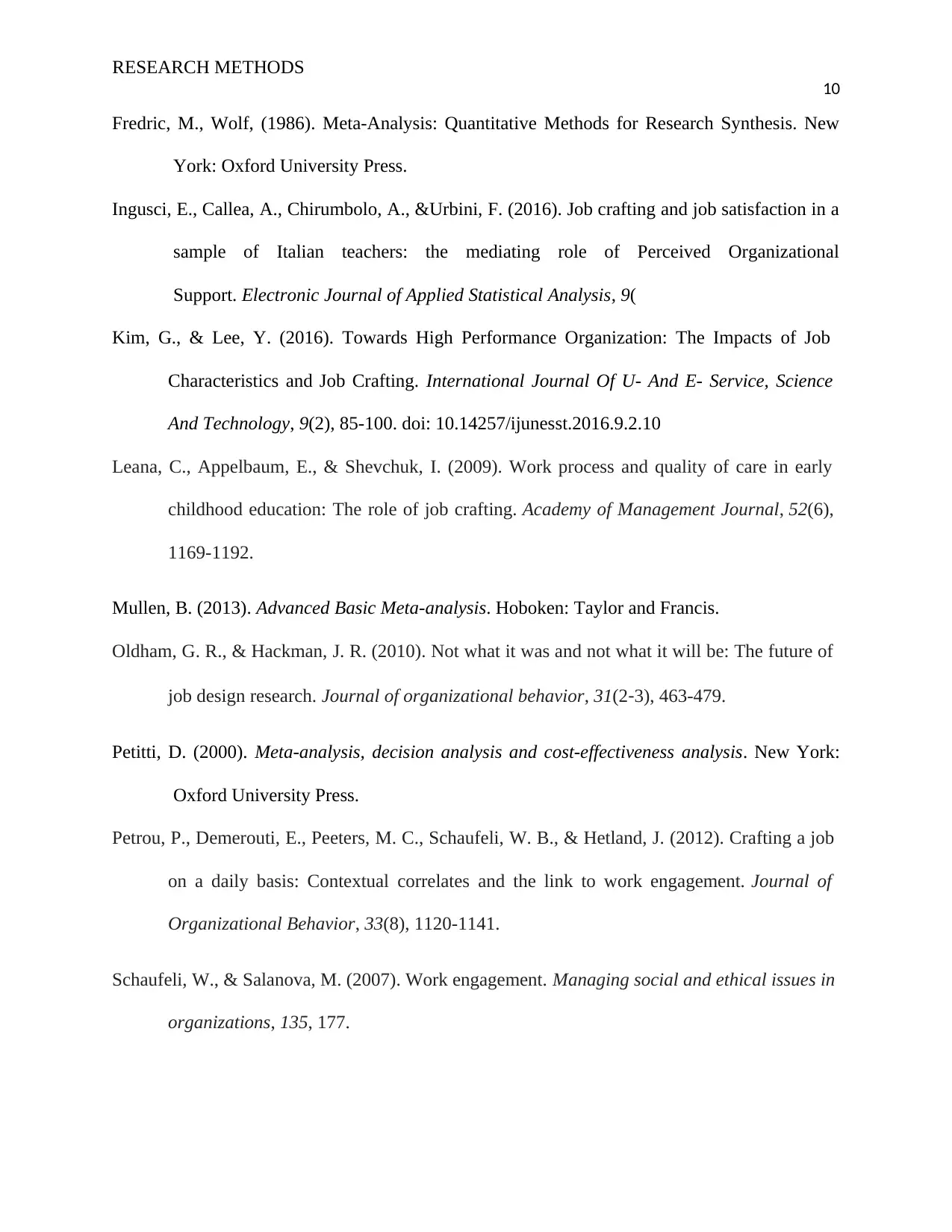
RESEARCH METHODS
10
Fredric, M., Wolf, (1986). Meta-Analysis: Quantitative Methods for Research Synthesis. New
York: Oxford University Press.
Ingusci, E., Callea, A., Chirumbolo, A., &Urbini, F. (2016). Job crafting and job satisfaction in a
sample of Italian teachers: the mediating role of Perceived Organizational
Support. Electronic Journal of Applied Statistical Analysis, 9(
Kim, G., & Lee, Y. (2016). Towards High Performance Organization: The Impacts of Job
Characteristics and Job Crafting. International Journal Of U- And E- Service, Science
And Technology, 9(2), 85-100. doi: 10.14257/ijunesst.2016.9.2.10
Leana, C., Appelbaum, E., & Shevchuk, I. (2009). Work process and quality of care in early
childhood education: The role of job crafting. Academy of Management Journal, 52(6),
1169-1192.
Mullen, B. (2013). Advanced Basic Meta-analysis. Hoboken: Taylor and Francis.
Oldham, G. R., & Hackman, J. R. (2010). Not what it was and not what it will be: The future of
job design research. Journal of organizational behavior, 31(2‐3), 463-479.
Petitti, D. (2000). Meta-analysis, decision analysis and cost-effectiveness analysis. New York:
Oxford University Press.
Petrou, P., Demerouti, E., Peeters, M. C., Schaufeli, W. B., & Hetland, J. (2012). Crafting a job
on a daily basis: Contextual correlates and the link to work engagement. Journal of
Organizational Behavior, 33(8), 1120-1141.
Schaufeli, W., & Salanova, M. (2007). Work engagement. Managing social and ethical issues in
organizations, 135, 177.
10
Fredric, M., Wolf, (1986). Meta-Analysis: Quantitative Methods for Research Synthesis. New
York: Oxford University Press.
Ingusci, E., Callea, A., Chirumbolo, A., &Urbini, F. (2016). Job crafting and job satisfaction in a
sample of Italian teachers: the mediating role of Perceived Organizational
Support. Electronic Journal of Applied Statistical Analysis, 9(
Kim, G., & Lee, Y. (2016). Towards High Performance Organization: The Impacts of Job
Characteristics and Job Crafting. International Journal Of U- And E- Service, Science
And Technology, 9(2), 85-100. doi: 10.14257/ijunesst.2016.9.2.10
Leana, C., Appelbaum, E., & Shevchuk, I. (2009). Work process and quality of care in early
childhood education: The role of job crafting. Academy of Management Journal, 52(6),
1169-1192.
Mullen, B. (2013). Advanced Basic Meta-analysis. Hoboken: Taylor and Francis.
Oldham, G. R., & Hackman, J. R. (2010). Not what it was and not what it will be: The future of
job design research. Journal of organizational behavior, 31(2‐3), 463-479.
Petitti, D. (2000). Meta-analysis, decision analysis and cost-effectiveness analysis. New York:
Oxford University Press.
Petrou, P., Demerouti, E., Peeters, M. C., Schaufeli, W. B., & Hetland, J. (2012). Crafting a job
on a daily basis: Contextual correlates and the link to work engagement. Journal of
Organizational Behavior, 33(8), 1120-1141.
Schaufeli, W., & Salanova, M. (2007). Work engagement. Managing social and ethical issues in
organizations, 135, 177.
Paraphrase This Document
Need a fresh take? Get an instant paraphrase of this document with our AI Paraphraser
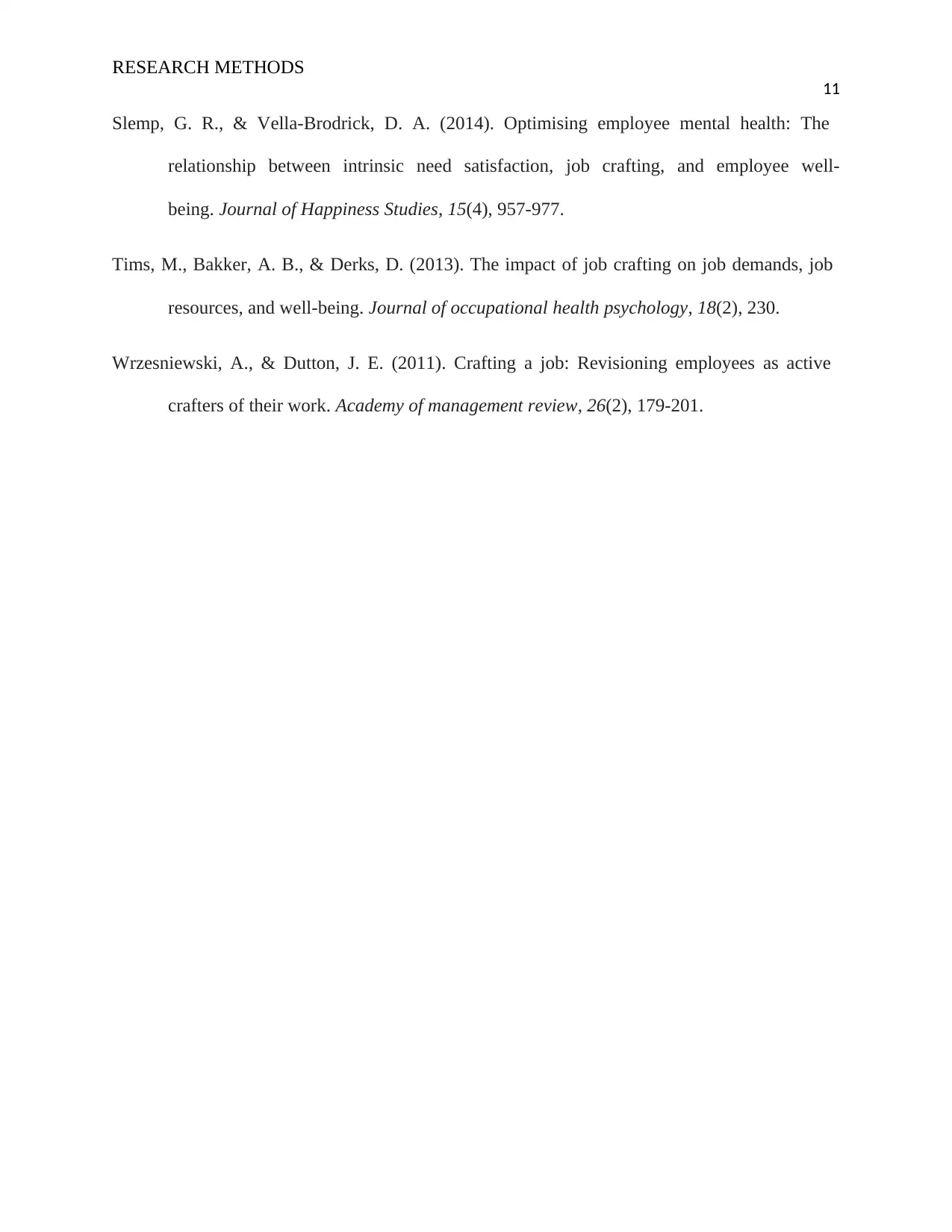
RESEARCH METHODS
11
Slemp, G. R., & Vella-Brodrick, D. A. (2014). Optimising employee mental health: The
relationship between intrinsic need satisfaction, job crafting, and employee well-
being. Journal of Happiness Studies, 15(4), 957-977.
Tims, M., Bakker, A. B., & Derks, D. (2013). The impact of job crafting on job demands, job
resources, and well-being. Journal of occupational health psychology, 18(2), 230.
Wrzesniewski, A., & Dutton, J. E. (2011). Crafting a job: Revisioning employees as active
crafters of their work. Academy of management review, 26(2), 179-201.
11
Slemp, G. R., & Vella-Brodrick, D. A. (2014). Optimising employee mental health: The
relationship between intrinsic need satisfaction, job crafting, and employee well-
being. Journal of Happiness Studies, 15(4), 957-977.
Tims, M., Bakker, A. B., & Derks, D. (2013). The impact of job crafting on job demands, job
resources, and well-being. Journal of occupational health psychology, 18(2), 230.
Wrzesniewski, A., & Dutton, J. E. (2011). Crafting a job: Revisioning employees as active
crafters of their work. Academy of management review, 26(2), 179-201.
1 out of 11
Related Documents
Your All-in-One AI-Powered Toolkit for Academic Success.
+13062052269
info@desklib.com
Available 24*7 on WhatsApp / Email
![[object Object]](/_next/static/media/star-bottom.7253800d.svg)
Unlock your academic potential
Copyright © 2020–2025 A2Z Services. All Rights Reserved. Developed and managed by ZUCOL.





